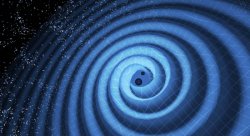Listening to the Universe
Scientists proving Einstein’s theories usher in new field of gravitational-wave astronomy
Posted in: CSAM Research, Mathematics

Gravitational waves – ripples in the geometry of space and time – were first predicted by Albert Einstein in 1916. A century later – on September 14, 2015 – the first detection of a gravitational-wave signal, produced by the merger of two black holes, was made by a new instrument called LIGO. A second black hole binary merger was detected on Christmas of that year and a third was observed in January of 2017. These events mark the birth of a new field, gravitational-wave astronomy.
The Laser Interferometer Gravitational-wave Observatory (LIGO) is a $500 million, National Science Foundation-funded project consisting of 2.5-mile-long L-shaped interferometers separated by roughly 2,400 miles (one is located in Louisiana, the other in the state of Washington). Gravitational waves jiggle the mirrors at the ends of each “arm” of the interferometer by about 1/1000th of a proton diameter; when light from each arm is recombined, the resulting fluctuations in the interference pattern allow us to infer properties of what produced the waves.
As more black hole mergers are detected (we expect at least a few per year), we’ll be able to answer some key questions: Did these black holes form in regions where the density of stars is low or high? How did those stars interact and evolve before they became black holes? Is Einstein right? Or does another theory of gravity provide a better fit to observations. The LIGO group at Montclair State is helping to make progress on these questions.
One important area of gravitational-wave research is producing better models of merging compact stars when their orbits are elliptical. Using these models, we can understand how well LIGO can constrain the ellipticity of a binary’s orbit (which tells us about how the binary formed). We are also exploring how ellipticity can bias our measurements of the binary’s masses and spins or contaminate our tests of Einstein’s theory (by mimicking a different gravity theory). Another project explores a slowly varying component of the gravitational-wave signal called the “memory effect.” This provides information about a nonlinear interaction in which gravitational waves themselves produce more waves. LIGO or future instruments should eventually observe this phenomenon.
Our work at Montclair State is supported by a National Science Foundation CAREER grant and has involved students Kevin Chen, Lita de la Cruz, Matthew Karlson and recent graduates Goran Dojcinoski, Nicholas Drywa and Blake Moore. New faculty member Rodica Martin has also recently joined our group, bringing expertise in experimental optics. Along with the above projects, all students are involved in public outreach – including the development of soundsofspacetime.org, a website that explores the physics of gravitational waves via an analogy with sound (both easily penetrate dense regions and are produced by macroscopic motions as opposed to microscopic ones).
What is this all good for? Simply the “pleasure of finding things out” – understanding how nature works the way it does. LIGO provides the ears that let us perceive our universe in an entirely new way.
This article was written by Professor Marc Favata and will appear in the Fall 2017 issue of Insights, the Research Chronicle of the College of Science and Mathematics.
